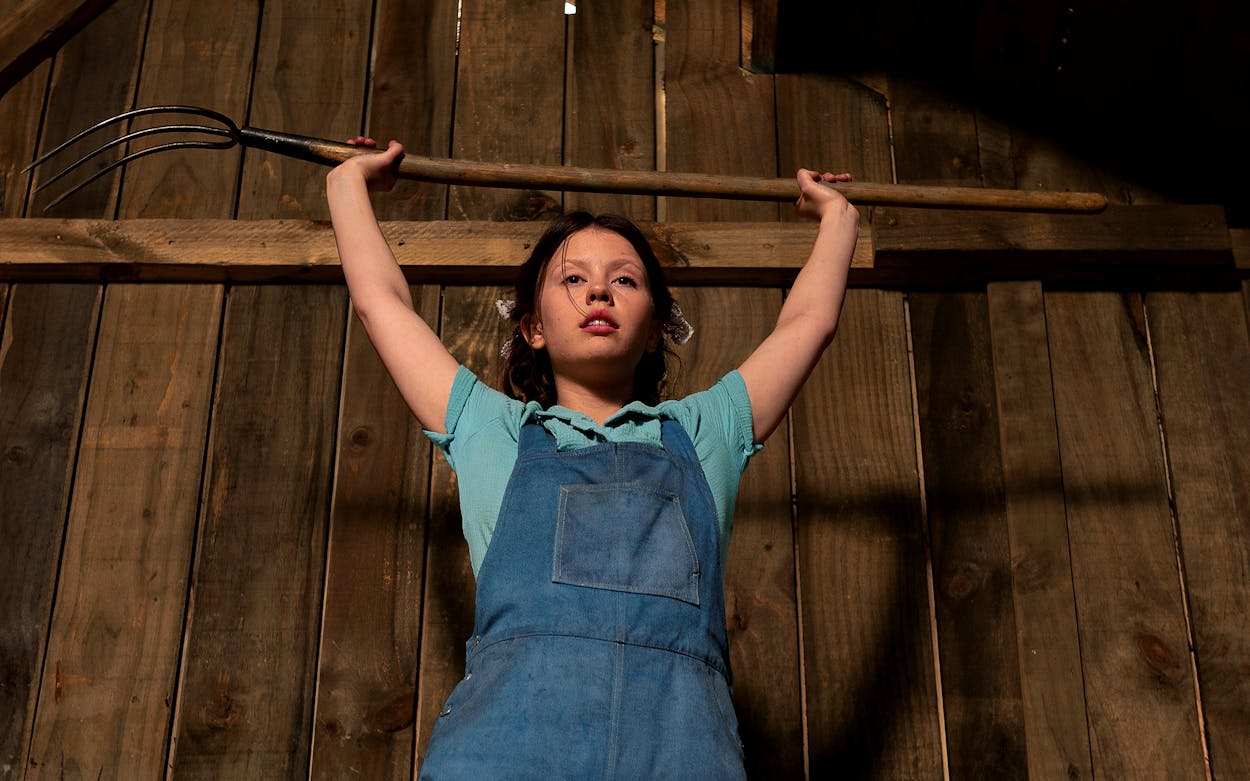A bloodthirsty young woman who cuts down her victims with an axe and feeds one to an alligator is the female icon Gen Z didn’t know it wanted.
Soon after the release last month of Pearl, Gen Z fans dubbed it the “women’s Joker,” referring to Joaquin Phoenix’s 2019 portrayal of the Batman villain as an alienated and frustrated man pushed into nihilistic violence by a hypocritical society. In Pearl, girls seem to have found their antihero, who, pushed beyond desperation, relentlessly swings back at the people and society that keep her repressed and confined to a life of narrowly defined prospects.
Pearl is director Ti West’s prequel to his movie X, which premiered at this year’s South by Southwest festival in Austin. X follows a group of twentysomethings in the seventies who set out from Houston to an isolated farm to shoot an adult film, until their frolicking is cut short, quite literally, by the farm’s elderly owners, Pearl and her husband, Howard. Pearl despises the wannabe actors, who flaunt their youth and beauty, triggering Pearl’s insecurities about her lost youth and muffled aspirations. Mia Goth plays both Pearl (under heavy prosthetics) and one of the young filmmakers, Maxine, who dreams of movie stardom and believes the skin flick is her ticket out of the anonymity of unrealized ambitions.
In the new film, set roughly sixty years before the bloody events of X, when Pearl was about Maxine’s age, Pearl has similar ambitions—but in her case, she hopes to become a famous dancer. (Another similarity with Joker: Phoenix’s Arthur Fleck also dreams of being in show business, as a stand-up comedian.) But Pearl is stymied by her family: her conservative, strict mother, Ruth (Tandi Wright); her mute, invalid father (Matthew Sunderland) who needs constant care; and Howard, Pearl’s husband, who is overseas fighting in World War I, but who loves the family farm—the same one where the young filmmakers meet their bloody fates in X—that Pearl hates and desperately wants to leave.
Ruth is Pearl’s main antagonist and represents the inverse of Pearl’s desire: Ruth accepts the life that her family and society deem she deserves. Worse, she expects the same of Pearl. Ruth warns Pearl of life hardly ever turning out the way one hopes, and that if Pearl ever wants to be happy, she needs to accept her station.
Carrying out her home duties, however, leaves Pearl feeling lonely, alienated, and more than a little sexually frustrated, which at one point she lets out on a scarecrow. (This is the prequel to X, after all, and a third installment, MaXXXine, is in the works.) Pearl believes she’s meant for greater things, which puts her on a crash course with her mother, who sees Pearl as selfish and ungrateful for thinking their home and family are beneath her. When opportunities for Pearl to potentially escape the farm and become a dancer present themselves, in the forms of a handsome projectionist at the local theater who encourages Pearl and her sister-in-law’s invitation to an audition to join a traveling dance troupe, she lunges at them—and decides she would do anything to realize her dreams.
West shot Pearl on the same set in Australia he used for X. And just as X’s visual style was filled with homages to campy horror films from the seventies, Pearl’s tips its cap to Old Hollywood studio productions, down to the opening credits’ melodramatic orchestral soundtrack. More pleasing to the eye than X, which featured too many dark, difficult-to-see scenes, Pearl’s bright reds and blues bring an old-timey feel to the film, making it like a perverse Wizard of Oz, especially during the X-rated scarecrow scene. West’s brisk pacing keeps the audience guessing about when Pearl will lurch further into madness. It’s a beautiful film, bloody bits and all.
But more than West’s directorial artistry, the standout performance in Pearl is Goth’s, who gracefully slides between doe-eyed naivete and all-consuming rage, culminating in an amazing, nine-minute, almost entirely uncut monologue that is at once heartfelt and terrifying. Goth’s commitment to the role is what makes this visually striking film a fun watch. She’s unafraid to let out childlike tantrums and murderous screeches that sound like they’re coming from some barely contained animal living inside her.
Goth’s singular performance again recalls Phoenix’s in Joker, right down to the end credits scene, a three-minute shot of Pearl smiling painfully wide from ear to ear as tears roll slowly down her cheeks. (Even the font of “The End” is eerily similar to that in Joker.)
More than just a horror movie, Pearl is for the girls who try so hard yet never feel good enough, who wish they could let out their rage after feeling one too many stings. Fans have been ironically tweeting lines like “She’s just like me” alongside dramatic clips, such as one of Pearl melting down in the face of perceived rejection.
Pearl brings edge-of-your-seat gory horror, but it also portrays a young woman feeling obsessive and lonely all at once. She’s a madwoman, but as with Arthur Fleck, you can’t help but root for her a little bit. Hopefully more horror films will have female characters like Pearl, because why can’t women be the bad guys sometimes?






